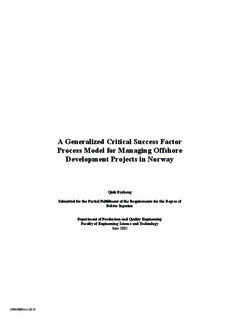| dc.description.abstract | Managing offshore development projects in Norway is no doubt a challenging task because such projects often involve large capital investments with risks under dynamic and complex environments. Project managers play a critical role for project success. This study concentrates on project core team level of management.
The study focuses on one major task of project managers: top-down identification, communication and monitoring of management focuses in order to lead an organization towards the same goals/success. There are three steps: demonstrate that a need for a new tool for this purpose exists; further develop a generalized critical success factor (CSF) process model to meet such a need; test the model in real-time Statoil offshore development projects through a multiple-case study design. Four research questions (see Figure 3-1 The four research questions in this study) are formulated accordingly and answered.
Through the case studies, it is clear that goal definition and breakdown is management lore also practiced well in offshore development projects. Definition of task, responsibility and authority is also attended to. Good project managers all have a picture of what is critical for their projects at each time, yet often implicitly. Mangers agree that it is manager’s responsibility to let the project organization know what is the most important and dangerous for the project at any time. However, besides project governing documents, which is event independent, risk register and regular meetings, much of such communication happens informally. We can also demonstrate that risk register covers just part of management focuses. Different CT members have different understanding of project management focuses and priorities among them. Subjective evaluation is extensively used to evaluate the status in management focuses, sometimes according to implicit or even different criteria. It is therefore clear that a structured tool is needed to ensure good identification, communication and monitoring of top-down management focuses.
A management tool, called a generalized Critical Success Factor (CSF) process model, is therefore further developed for this purpose. The model is based on semi-structured interviews with all project core team members except Administration (secretary function), which is considered having a function with too little management responsibility.
The model has two parts in data collection. The first part aims at retrieving interviewees’ perception of their jobs, their understanding of project success criteria, the role of project core team and their management information sources. This part helps one understand the team dynamics and thoughts behind individual actions. The other part is a comprehensive and systematic list made of eleven (11) categories for identification of critical activities for reaching project success. These activities are then grouped into related topics. Consistency and criticality checks are carried out within and among the groups. Each group is then given a title in terms of activity and becomes a critical success factor (CSF). The result is presented to CT manager or CT for comments and necessary revisions are made.
The two cases in the multiple-case design show the generality of the model by analytic generation rather than statistical enumeration. The CSFs found are explicit and project specific. The CSF results are purely based on managers’ statement in the interviews with no interpretation by the author. It is clear that CT members contribute to better quality of CSF identification comparing to the situation where only CT manager is involved. This supports the introduction of team-CSF approach in the model developed. This model contributes to better communication (vertically between the CT manager and her team and horizontally among the CT members) through making management focuses explicit, documenting them and reaching consensus.
However, the study shows that managers experience difficulty in identifying a set of measures representing the identified CSFs. The measures suggested, following the principle suggested by Dobbins [Dobbins, 2000], are not representative or concise enough. Other method than pure interviews may have to be tried out in this aspect in future studies in order to reach the full potential and acceptance of this model by practitioners, for example one can develop a questionnaire based on focused literature review on the identified CSFs, the use of which can facilitate interviewees in identifying good measures for their project.
This tool is logic with low application threshold. Managers have full control of the results. It can help discover potential conflicts or problems and allow for modifications both in and outside project organization. It offers a channel between project and outsiders, academic and practitioner alike. It is also a step towards better-documented management process. | nb_NO |
